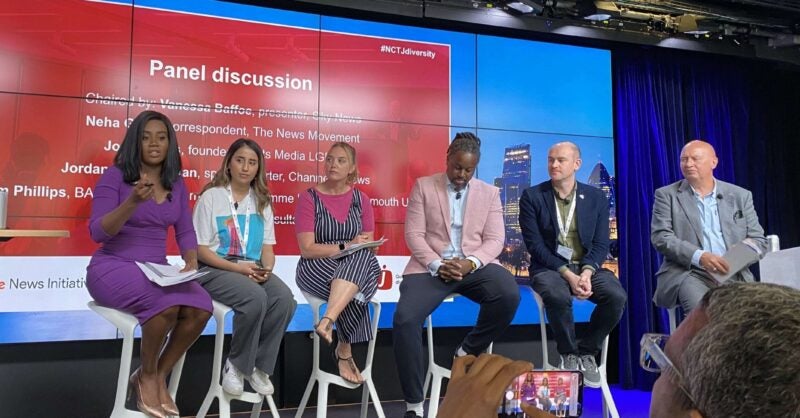The first NCTJ Diversity in Journalism analysis of the proportion of LGBTQ journalists suggests the group may be better represented in the news industry than it is among the general population.
But the NCTJ’s report for 2023 also identified multiple areas in which the news industry under-represents certain demographic groups – in particular women and working-class people.
And although the report’s author was hesitant to draw firm conclusions from a single year’s data, the figures suggest there were fewer journalists working in the UK in 2022 than there were a year earlier.
[Read more: 2022 NCTJ report – Working class representation in UK journalism hits record low]
Straight reporting, gay reporters: LGBTQ representation in UK journalism
The report’s figures draw on the Office for National Statistics’ Labour Force Survey (LFS), which is filled out by 60,000 households in the UK each quarter.
Its author, Mark Spilsbury, warned at a launch event on Thursday, that because this analysis begins by disaggregating journalists and then disaggregating demographic groups within journalism, some of the samples on which the report’s figures are based are relatively small. However, he said he felt the data was “by and large usable”.
The LFS figures suggest that 89% of journalists identify as heterosexual – versus 96% of the general population. Spilsbury noted that the LFS questions about sexuality were optional to fill out, and an unusually high 6% of respondents declined to answer that part of the survey.
Content from our partners
The NCTJ report also looked at 2021 census figures for its sexuality analysis. The census put the proportion of heterosexual journalists lower than the LFS, at 92%, and suggested gay and lesbian people are twice as well represented in journalism (4%) than in the general population (2%) and bisexual people (also 4%) were four times as well represented (1%).
One significant development in 2023’s NCTJ report is it shows, for the first time in years, a decline in the number of working journalists in the UK overall.
The number of journalists in the LFS increased consistently from 2017 (73,000) to 2021 (108,000) but dropped in 2022 to 101,500. However, it should again be noted these figures are extrapolated from the small subset of the 60,000 interviewees who said they worked as journalists.
There have been numerous job losses across the media over the last year, which may account for a drop. Academics and the National Union of Journalists warned in October that spiking costs and flat pay might encourage people out of journalism.
[Read more: UK and North American news media have cut 3,300+ jobs so far in 2023]
The proportion of women in journalism may have decreased
Also decreasing year-on-year was the proportion of women in journalism. Only 41% of journalists in the LFS figures for 2022 were women, a 12 percentage point drop on 2020 when they briefly outnumbered men. That leaves 2022 with the worst figures for journalism gender parity in the entire period covered by the report.
Press Gazette reported last month that the gender pay gap at UK media companies stands at 12% – a difference that presumably puts more women at risk of being squeezed out of journalism as the cost of living rises than men.
The 2022 NCTJ report put the number of journalists from professional and upper class backgrounds at 80%, versus 42% of the general population.
The 2023 report puts that figure for journalists at 72%, although the limited nature of the data means any given year’s report has a hampered capacity to indicate a true trend down.
What does appear to be improving, however, is the representation of people in journalism who have a work-limiting health problem or disability. The figures for this demographic have been steadily increasing since 2016 (10% of LFS respondents) and now stand at 22%.
Representation of ethnic minorities in UK journalism
Representation of people of colour is largely static on last year. White journalists made up 88% of the total group in the 2023 figures, a slight increase on 87% last year but a decrease on 2016 (90%) and 2018 (94%).
Spilsbury wrote in the report that the longer-term increase in people of colour working as journalists “is bringing employment in journalism in line with employment across all UK-sectors”. LFS figures indicate 86% of the UK workforce is white, meaning the media employs a proportionally smaller number of people of colour than the country as a whole.
A panel at the launch event noted that despite gains, people of colour were not necessarily progressing beyond junior positions in the newsroom. BBC News presenter Clive Myrie made a similar observation in March when he told the Society of Editors that, although the BBC had improved minority representation during his career, it had failed to promote marginalised groups into leadership positions.
That observation is supported by the NCTJ report, which notes that “a higher proportion of journalists and reporters are from other ethnic groups (14%) compared to editors (6%)”.
The panel also warned that young people, particularly from working class backgrounds, faced opposition at home from entering journalism because it is seen as an unstable trade – something panellist Neha Gohil from The News Movement said could only be improved if the industry offered “sustainable, secure jobs”.
She added that greater inclusion of people of colour in the newsroom and in coverage made sense commercially: “There’s so much potential in this industry – if it really invests in diversity and inclusion, you will be able to reach audiences that otherwise might be avoiding news, they might not trust the news, but if we really as an industry show that it’s such a priority, it will really translate to the audience.”
Email pged@pressgazette.co.uk to point out mistakes, provide story tips or send in a letter for publication on our “Letters Page” blog
